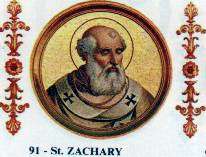Pope Zachary
- Pope Zacharias redirects here. It can also refer to Pope Zacharias of Alexandria.
| Pope Saint Zachary | |
|---|---|
 | |
| Papacy began | 3 December or 5 December 741 |
| Papacy ended | 15 March 752 |
| Predecessor | Gregory III |
| Successor | Pope-elect Stephen |
| Personal details | |
| Birth name | Zacharias son of Polichronius |
| Born |
679 Santa Severina, Calabria, Byzantine Empire |
| Died |
15 March 752 Rome, Byzantine Empire |
Pope Zachary (Latin: Zacharias; 679 – 15 March 752)[1] reigned from 3 December[1] or 5 December 741[2] to his death in 752. A Greek from Santa Severina,[3] Calabria, he was the last pope of the Byzantine Papacy. Most probably he was a deacon of the Roman Church and as such signed the decrees of the Roman council of 732 and was on intimate terms with Gregory III, whom he succeeded on 5 December 741.[2]
Life
Zachary was a wise and subtle diplomat. His predecessor's alliance with the Lombard Duke of Spoleto put papal cities at risk when the Dukes of Spoleto and Benevento rebelled. Zachary turned to King Liutprand the Lombard directly. Out of respect for Zachary the king restored to the church of Rome all the territory seized by the Lombards and sent back the captives without ransom.[4] The contemporary history (Liber pontificalis) dwells chiefly on Zachary's great personal influence with Liutprand, and with his successor Ratchis. His tact in dealing with these princes in a variety of emergencies contributed to save the Exarchate of Ravenna from the Lombard attacks.[2]
A correspondence of considerable extent and of great interest between Zachary and Saint Boniface, the apostle of Germany, survives, and shows how great was the influence of this pope on events in France and Germany. He encouraged the deposition of the last Merovingian king of the Franks, Childeric III, and it was with his sanction that Boniface crowned Pepin the Short as King of the Franks at Soissons in 752. Zachary is stated to have remonstrated with the Byzantine emperor Constantine V Copronymus on the part he had taken in the iconoclastic controversy.[2]
In the effort to Christianize Rome, Zachary built the original church of Santa Maria sopra Minerva over an ancient temple to Minerva near the Pantheon. He also restored the Lateran Palace, moving the relic of the head of Saint George to the church of San Giorgio al Velabro. Also in Rome, some Venetian merchants bought many slaves in the city to sell to the Muslims of Africa; however, Zachary forbade such traffic and then paid the merchants their price, giving the slaves their freedom.[4][5]
Pope Zachary died on 15 March[1] 752 and was buried in St. Peter's Basilica. His successor was Stephen, who died soon before his consecration and is not considered a valid pope. He was then succeeded by another Stephen who became Stephen II.
The letters and decrees of Zachary are published in Jacques Paul Migne, Patrolog. lat. lxxxix. p. 917–960.
See also
References
- 1 2 3 Miranda, Salvador. "The Cardinals of the Holy Roman Church". Retrieved 9 July 2015.
- 1 2 3 4 Kirsch, Johann Peter (1912). "Pope St. Zachary". The Catholic Encyclopedia. 15. New York: Robert Appleton Company. Retrieved 24 January 2014.
- ↑ "Itineraries". Le Puzelle. Retrieved 9 July 2015.
- 1 2 Butler, Alban (1866). "Zachary, Pope and Confessor". The Lives of the Fathers, Martyrs, and Other Principal Saints. III. Dublin: James Duffy.
- ↑ Stefan K. Stantchev (3 Jul 2014). Spiritual Rationality: Papal Embargo as Cultural Practice. Oxford University Press. p. 28. ISBN 9780191009235.
External links
 Herbermann, Charles, ed. (1913). "Pope St. Zachary". Catholic Encyclopedia. New York: Robert Appleton Company.
Herbermann, Charles, ed. (1913). "Pope St. Zachary". Catholic Encyclopedia. New York: Robert Appleton Company. This article incorporates text from a publication now in the public domain: Chisholm, Hugh, ed. (1911). "St. Zacharias". Encyclopædia Britannica (11th ed.). Cambridge University Press.
This article incorporates text from a publication now in the public domain: Chisholm, Hugh, ed. (1911). "St. Zacharias". Encyclopædia Britannica (11th ed.). Cambridge University Press.
| Catholic Church titles | ||
|---|---|---|
| Preceded by Gregory III |
Pope 3 December or 5 December 741 – 15 March 752 |
Succeeded by Stephen II |

